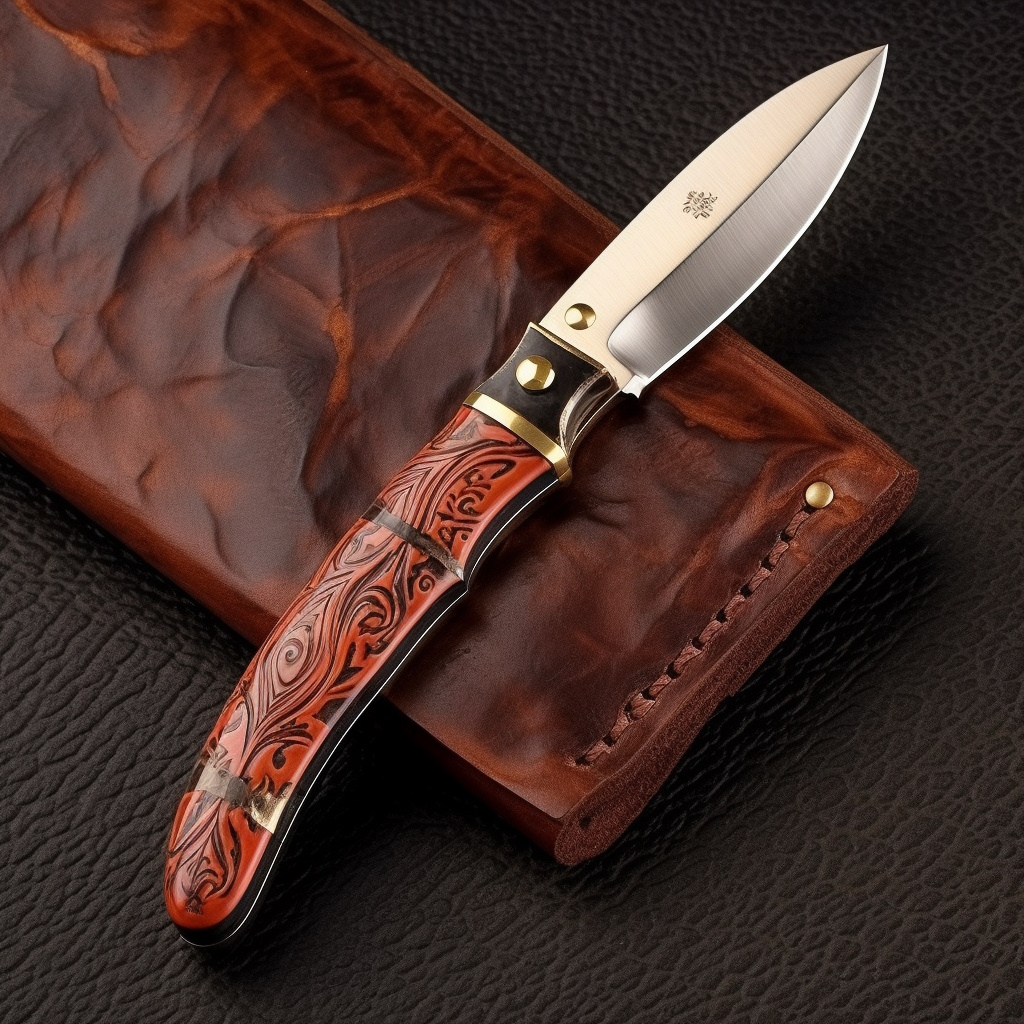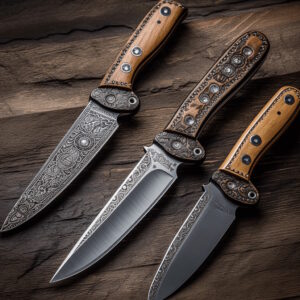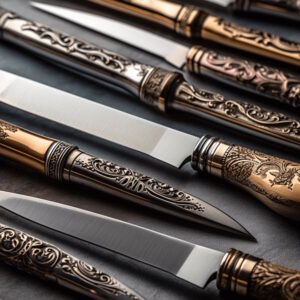Welcome! Go to your Account

Introduction
Welcome to the world of knife customization! Whether you’re a seasoned knife enthusiast or just starting to explore this fascinating craft, this comprehensive guide is here to provide you with the knowledge and insights you need to personalize your blade. From improving functionality to enhancing aesthetics, knife customization offers a unique opportunity to create a truly one-of-a-kind tool that reflects your individual style and preferences.
In this article, we will delve into the art of knife customization, covering everything from the basics to advanced techniques. We’ll explore the reasons why you might want to customize your knife, discuss the tools and materials you’ll need, and provide step-by-step instructions for various customization options. By the end, you’ll have a solid foundation to embark on your own knife customization journey.

Why Customize Your Knife?
Before we dive into the specifics of knife customization, let’s take a moment to understand why it has become such a popular practice among knife enthusiasts. Customizing your knife offers a range of benefits and appeals to different individuals for various reasons.
Functionality
One of the primary motivations behind knife customization is improving the functionality of the blade. Different people have different preferences when it comes to the handle shape, grip, and overall ergonomics of a knife. By customizing these elements, you can create a knife that fits your hand perfectly and enhances your cutting experience. Additionally, modifications to the blade itself, such as altering the edge geometry or adding serrations, can optimize its cutting performance for specific tasks.
Aesthetics
Another major reason to customize your knife is to enhance its visual appeal. Knife enthusiasts take great pride in owning unique and eye-catching blades. By personalizing your knife, you can add a touch of individuality and showcase your personal style. Whether it’s choosing different handle materials, adding decorative elements, or engraving meaningful designs, customization allows you to transform a standard knife into a work of art that reflects your personality.
Collectability and Investment
Customized knives also hold great value for collectors and investors. Handcrafted knives by renowned custom knife makers often appreciate in value over time, making them excellent investments. Additionally, limited-edition or one-off custom knives can become highly sought after by collectors, further increasing their desirability and worth. By personalizing your knife with custom work, you can potentially turn it into a valuable and unique piece in your collection.
Understanding the Basics of Knife Customization
To begin your journey into knife customization, it’s essential to familiarize yourself with the fundamental aspects of this art form. In this section, we’ll cover the basics, including choosing the right knife for customization and the tools and materials you’ll need.
Choosing Your Knife
Not all knives are created equal when it comes to customization potential. Some knife models have a wide range of aftermarket parts available, making them ideal candidates for customization. Benchmade and Spyderco are two popular knife brands known for their modifiability. These companies often collaborate with custom knife makers and offer models with interchangeable parts, allowing enthusiasts to easily personalize their blades.
When selecting a knife for customization, consider factors such as the availability of aftermarket parts, the construction quality of the knife, and the specific features you’re interested in modifying. Research different models and consult online forums or knife communities to get recommendations from experienced enthusiasts.

Tools and Materials for Knife Customization
To bring your customization ideas to life, you’ll need a set of tools and materials specifically designed for working on knives. Here are some essential items you should have:
Make sure to gather all the necessary tools and materials before starting any customization project. This will ensure a smoother workflow and minimize interruptions during the process.
The Specifics of Knife Customization
Now that you have a good understanding of the basics, let’s dive into the exciting world of knife customization. In this section, we’ll explore specific areas where you can personalize your knife, including handle scales, hardware customization, pocket clips, and edge maintenance.
Handle Scales
Handle scales are an integral part of a knife’s handle. They not only provide a comfortable grip but also contribute to the overall aesthetics of the knife. There are various materials and designs available for handle scales, allowing you to customize this aspect according to your preferences.
Types of Handle Scales
How to Change Handle Scales
Changing the handle scales of a knife requires careful disassembly and reassembly of the knife. Here’s a general step-by-step guide:
Remember, the specific steps may vary depending on the knife model and construction. It’s always a good idea to consult the knife manufacturer’s guidelines or seek advice from experienced knife enthusiasts if you’re uncertain.
Hardware Customization
Customizing the hardware of your knife allows you to add a personal touch and enhance its functionality. From pivot screws to pocket clip options, there are several hardware components you can modify to achieve the desired look and performance.
Types of Hardware
How to Customize Knife Hardware
Customizing knife hardware typically involves disassembling and reassembling the knife, similar to changing handle scales. Here’s a general guide:
Again, it’s crucial to refer to the knife manufacturer’s guidelines or seek advice from experienced enthusiasts if you’re unsure about specific customization processes.
Pocket Clips
Pocket clips play a vital role in everyday carry (EDC) knives, allowing them to be securely and conveniently attached to pockets, belts, or other gear. Customizing the pocket clip can add a touch of personalization and improve the knife’s carry experience.
Types of Pocket Clips
How to Customize Pocket Clips
Customizing a pocket clip usually involves replacing the existing clip with a new one or modifying the existing clip. Here’s a general guide:
Keep in mind that not all knives have easily replaceable pocket clips. Some knives may require more advanced modifications or may not be compatible with aftermarket clips. Always consider the specific characteristics and limitations of your knife before attempting any customization.
Keeping Your Customized Knife in Top Shape
Congratulations on successfully customizing your knife! Now, it’s essential to maintain and care for your customized blade to ensure its longevity and optimal performance. In this section, we’ll discuss edge maintenance and modification, which are key aspects of keeping your knife in top shape.
Edge Maintenance and Modification
Maintaining a sharp and well-performing edge is crucial for any knife, whether it’s customized or not. Regular edge maintenance helps ensure that your knife remains efficient and safe to use. Here are some key points to consider:
Remember to follow proper safety precautions when working with sharp objects and cutting tools. Always read and adhere to the manufacturer’s guidelines for maintenance and use of your specific knife model.
Conclusion
Customizing your knife is a rewarding and creative endeavor that allows you to transform a standard blade into a personalized tool that reflects your style and preferences. In this comprehensive guide, we explored the art of knife customization, covering the benefits, the basics, and various customization options.
We discussed the importance of functionality and aesthetics in knife customization and highlighted the different materials and designs available for handle scales. Additionally, we explored hardware customization, including pivot screws, backspacers, clip screws, and pocket clips, which can add functionality and visual interest to your knife. Lastly, we emphasized the significance of edge maintenance and modification for keeping your customized knife in top shape.
Now that you have a solid foundation and understanding of knife customization, it’s time to embark on your own journey. Remember to start with small projects, practice your skills, and continuously learn from experienced enthusiasts. Happy customizing!